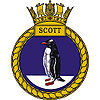HMS Scott (H131)
| 300px HMS Scott (H131) | |
| Career (UK) | |
|---|---|
| Name: | HMS Scott |
| Operator: | Royal Navy |
| Ordered: | 20 January 1995 |
| Builder: | Appledore Shipbuilders |
| Launched: | 13 October 1996 |
| Commissioned: | 30 June 1997 |
| Homeport: | HMNB Devonport, Plymouth |
| Identification: |
Pennant number: H131 International Callsign: GCUP |
| Status: | in active service, as of 2025[update] |
| Badge: |
 |
| General characteristics | |
| Class and type: | Scott-class Ocean Survey Vessel[1] |
| Displacement: | 13,500 tons full load |
| Length: | 131.1 m (430 ft) |
| Beam: | 21.5 m (71 ft) |
| Draught: | 8.3 m (27 ft) |
| Propulsion: |
|
| Speed: | 18 knots (33 km/h) |
| Complement: |
63 (42 onboard at any time) |
HMS Scott is an Ocean Survey Vessel (OSV) of the Royal Navy, and the only vessel of her class. She is the third Royal Navy ship to carry the name, and the second to be named after the Antarctic explorer, Robert Falcon Scott.
Construction
She was ordered from BAeSEMA in 1995 to replace the ageing HMS Hecla. She was built at the Appledore Shipbuilders in North Devon and launched on 13 October 1996 by Mrs Carolyn Portillo,[2] wife of Michael Portillo, the then-Secretary of State for Defence. She was commissioned on 20 June 1997. Not only is she the largest vessel in the Royal Navy's Hydrographic Squadron, and the sixth largest in the entire fleet, but she is also the largest survey vessel in Western Europe.
Role
Scott is now the Royal Navy's only Ocean Survey Vessel,[3] but she can remain at sea for up to 300 days a year, thanks to her novel crew rotation system. Her complement of 63 is divided into three sections: two sections are required to keep the ship operational, with the third on shore on leave or in training.[2] When the ship returns to port, one crew section on board is replaced by the section on shore. The ship can then deploy again almost immediately. As with all of the Royal Navy's large survey vessels, Scott has an auxiliary role in support of mine countermeasure vessels.
History
In February 2005 Scott surveyed the seabed around the 2004 Indian Ocean earthquake, which varies in depth between 1,000 m (3,300 ft) and 5,000 m (16,000 ft). The survey, conducted using a high-resolution, multi-beam sonar system, revealed that the earthquake had made a huge impact on the topography of the seabed.
In September 2006, Scott was granted the Freedom of the City of Swansea.[4]
From August 2008 until June 2009 Scott was refitted in Portsmouth.[5]
On 26 October 2009,[5] Scott deployed to the South Atlantic and Antarctic. This is in part to cover for the non-availability of the Royal Navy icebreaker HMS Endurance.[6]
Affiliations
- 42 Engineer Regiment (Geographic), Royal Engineers[7]
- City and County of Swansea[4][7]
- Plymouth Child Development Centre (Scott Hospital, Plymouth)[7]
- TS Scott - Maidstone Sea Cadets[7]
- The Captain Scott Society[7]
- The Worshipful Company of Water Conservators[7]
References
- ↑ "HMS Scott at armedforces.co.uk". http://www.armedforces.co.uk/navy/listings/l0020.html. Retrieved 2008-12-20.
- ↑ 2.0 2.1 "HMS Scott at the Royal Navy website". http://www.royalnavy.mod.uk/server/show/nav.1898. Retrieved 2008-11-15.
- ↑ "Hydrgraphic vessels at the Royal Navy website". http://www.royalnavy.mod.uk/server/show/nav.1842. Retrieved 2008-12-20.
- ↑ 4.0 4.1 "HMS Scott accepts Freedom of the City - City and County of Swansea website". http://www.swansea.gov.uk/index.cfm?articleid=14093. Retrieved 2008-11-15.
- ↑ 5.0 5.1 "HMS Scott: The Journey to the Ends of the Earth". Royal Navy website. 28 Oct 09. http://www.royalnavy.mod.uk/operations-and-support/surface-fleet/hydrographic-vessels/hms-scott/news/hms-scott-the-journey-to-the-ends-of-the-earth. Retrieved 2009-11-10.
- ↑ "HMS Scott deploys to Antarctic". Royal Navy website. 29 Oct 09. http://www.royalnavy.mod.uk/operations-and-support/surface-fleet/hydrographic-vessels/hms-scott/news/hms-scott-deploys-to-antarctic/*/changeNav/6568. Retrieved 2009-11-10.
- ↑ 7.0 7.1 7.2 7.3 7.4 7.5 "HMS Scott Charities and Affiliations at the Royal Navy website". http://www.royalnavy.mod.uk/server/show/nav.1905. Retrieved 2008-11-15.
| ||||||||||||||||||||||||||||||||||||||||||||||||||||||||||||||||||||||||||||||||||||||
- Pages using duplicate arguments in template calls
- Pages with broken file links
- Articles containing potentially dated statements from 2025
- Articles with invalid date parameter in template
- All articles containing potentially dated statements
- Royal Navy survey ships
- Ships built in England
- 1996 ships
- Unique ships
